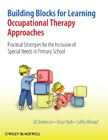
Building blocks for learning occupational therapyapproaches: practical strategies for the inclusion of special needs in primary school
Jenkinson, Jill
Occupational Therapy Approaches for Primary Special Needs is a resource book for educational staff and pediatric occupational therapists, especially those new to the field. It shows how the implications of physical, psychological, social, and learning difficulties impact upon children's abilities. This highly practical book will help readers recognize when a student's poor performance within the classroom is a result of a medical condition or underlying motor andperceptual deficits. INDICE: Foreword. Acknowledgements. Introduction. FOUNDATION SKILLS. Introduction to foundation skills. FS 1 Introduction to sensory processing. FS 2 Vestibular processing (movement and balance sense). FS 3 Tactile sense and tactile processing. FS 4 Proprioceptive processing/sense. FS 5 Auditory processing.FS 6 Visual processing. FS 7 Introduction to gross motor coordination. FS 8 Motor planning. FS 9 Postural stability and balance. FS 10 Spatial and body awareness. FS 11 Bilateral integration. FS 12 Midline crossing and laterality. FS13 Introduction to fine motor control. FS 14 Visual motor integration. FS 15 Vision and ocular motor control. FS 16 Manual dexterity. FS 17 Introduction toperception. FS 18 Visual discrimination. FS 19 Visual spatial relationships. FS 20 Visual form constancy. FS 21 Visual figure ground discrimination. FS 22 Visual closure. FS 23 Visual memory. FS 24 Introduction to language. FS 25 Attention and listening. FS 26 Receptive language. FS 27 Expressive language. FS 28 Auditory memory. FS 29 Organisation approaches. FS 30 Social and emotional aspects. SUBJECT AREAS. Introduction to subjects. General behaviour. Literacy.Numeracy. Science. Art and Design. ICT. PE. Subject area teacher observation summary chart. Personalised profile for child. MEDICAL CONDITIONS. Introduction to medical conditions. Attention deficit disorder/attention deficit hyperactivity disorder. Autistic spectrum including Asperger's syndrome. Cerebral palsy. Developmental coordination disorder including dyspraxia. Physical disabilities. OCCUPATIONAL THERAPY APPROACHES. Introduction to occupational therapy approaches. OTA 1 Building firm foundations for spatial and body awareness. OTA 2Building firm foundations for left/right awareness. General activities. Activities for left/right discrimination on oneself. Activities to help with left/right orientation on others. Activities to help left/right discrimination of objects. Activities to help with left/right orientation when writing. OTA 3 Building firm foundations for fine motor control. Warm up for the upper limb. Handwriting warm up. Hand gym. Ideas for using therapeutic putty. Pencil aerobics.Hand/finger relaxation strategies. OTA 4 Building firm foundations for handwriting. Handwriting. Development of pencil grasp. Efficient and inefficient grasps. Improving pencil grasps. Development of pencil skills. Three easy stages for teaching pencil grip. Equipment to help develop pencil grasp and fluency. Hand development for handwriting. Ergonomics. Functional working position in standing. Texture of writing paper or surface. Paper position. Position in class. Development of pencil skills. Multi-sensory handwriting approach. Consolidation for efficient handwriting. Rules for writing tasks. Activities to encourage self-evaluation of handwriting. Copying from the board. Specific advice forleft-handed children. OTA 5 Building firm foundations for alternative methodsof recording. Complexity of handwriting. Lo-tech alternatives. Word processing. Resources-software/hardware. Other alternatives -- part-prepared worksheets. Dictaphone. Stamps/magnetic letters. Thinking skills. Scribe. Word banks. OTA 6 Building firm foundations for dressing skills. OTA 7 Building firm foundations for scissor development. Developmental stages. Activities to develop abilities. OTA 8 Sensory strategies. OTA 9 Self-organisation approaches. OTA 10 Consolidating foundation skills through group activities. Establishing groups. Themed activity groups. Pirate activities. OTA 11 Consolidating foundation skills for transition from primary to secondary school. A 1 Ages and stages of development. A 2 Alphabet ABC sentences. A 3 Fine motor circuit. A 4 Handwriting self-evaluation checklist. A 5 Handwriting programmes and fine motor resources. A 6 ICT checklist. A 7 Movement programmes and gross motor resources. A 8 Proforma planning. A 9 Resources for developing social, emotional and behavioural skills. A 10 Teachers checklist for visual signs. A 11 Thinking skills. A 12Twelve rules of legibility. A 13 Visual perception materials. A 14 Work schedules Equipment Resources. Suppliers' Addresses. Useful Addresses. Further Reading. Glossary. Index.
- ISBN: 978-0-470-05857-2
- Editorial: John Wiley & Sons
- Encuadernacion: Cartoné
- Páginas: 448
- Fecha Publicación: 01/08/2008
- Nº Volúmenes: 1
- Idioma: Inglés
